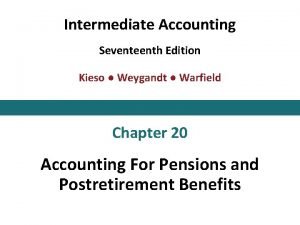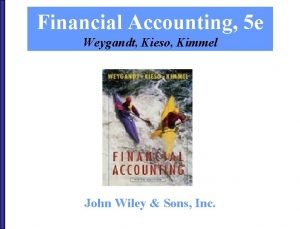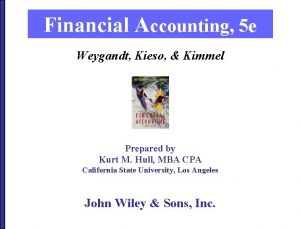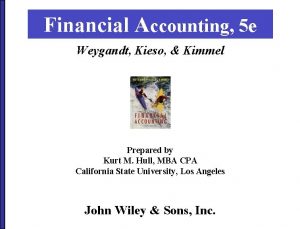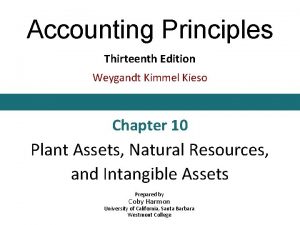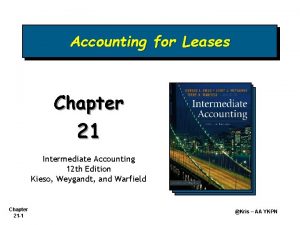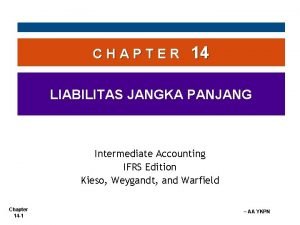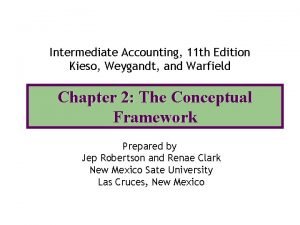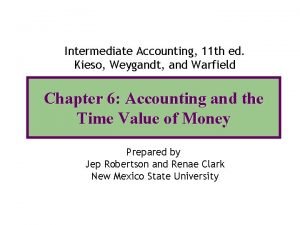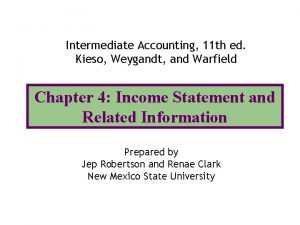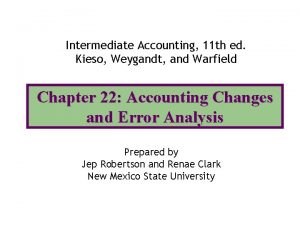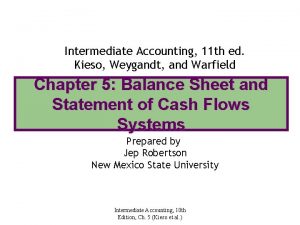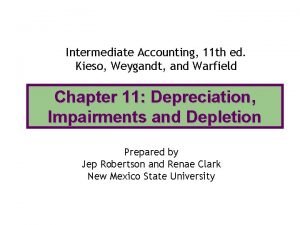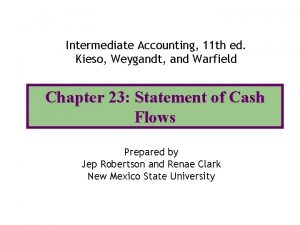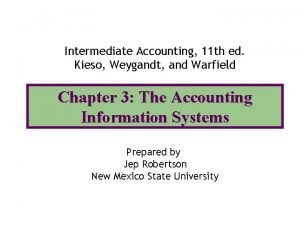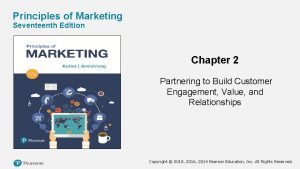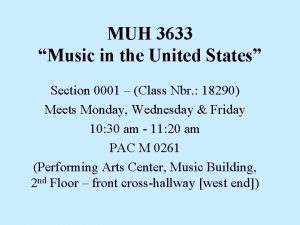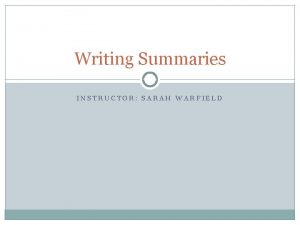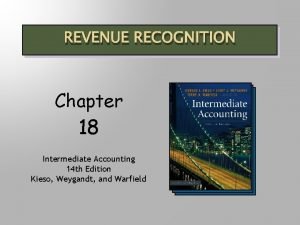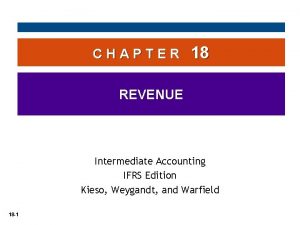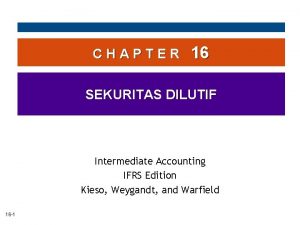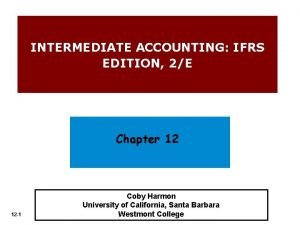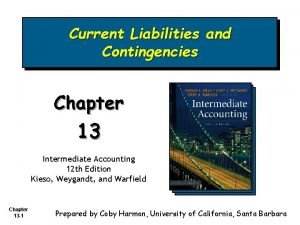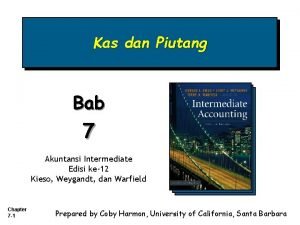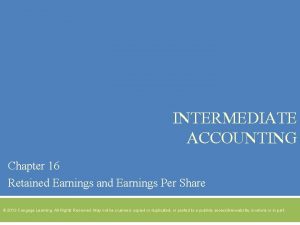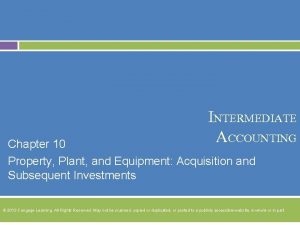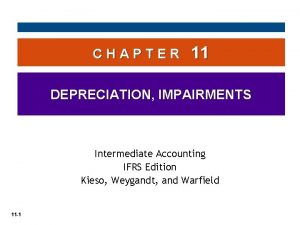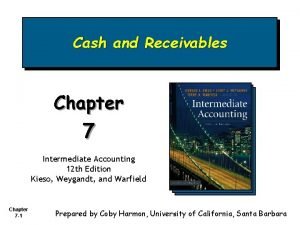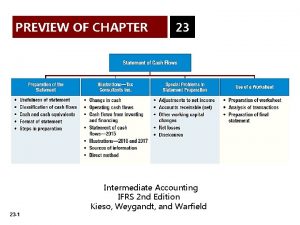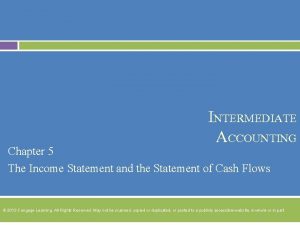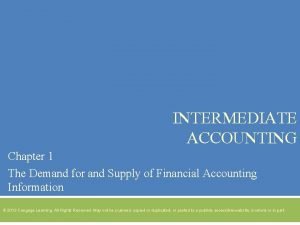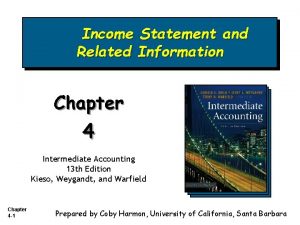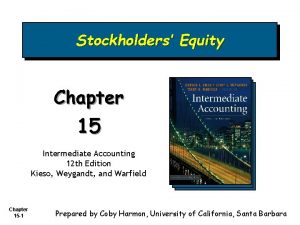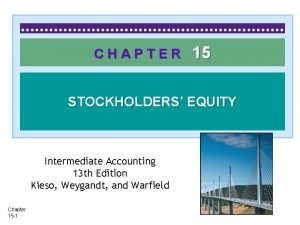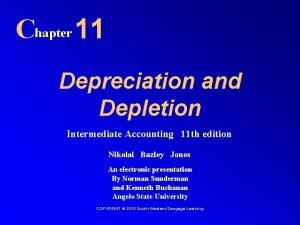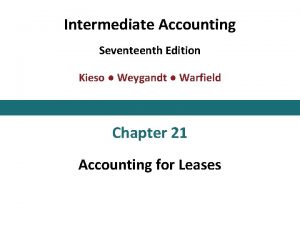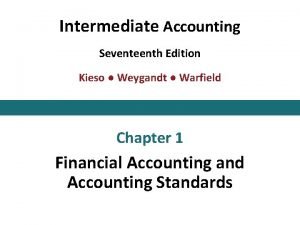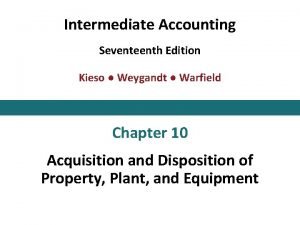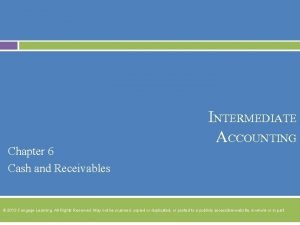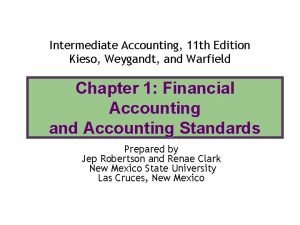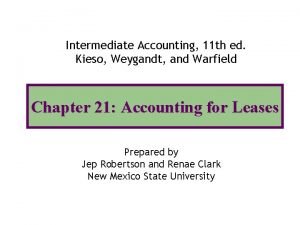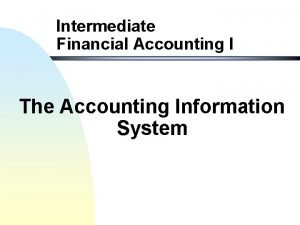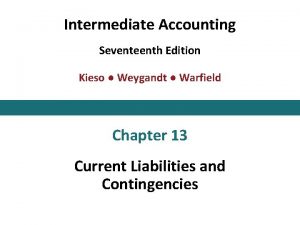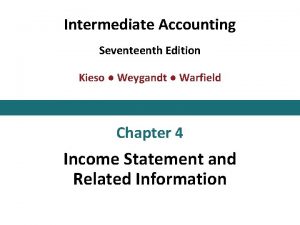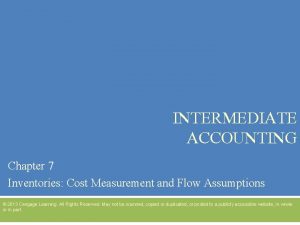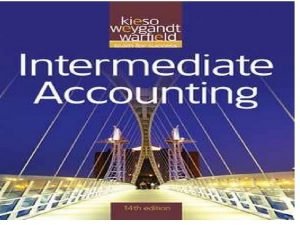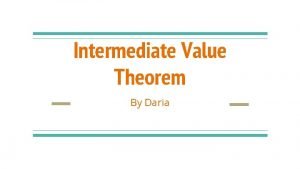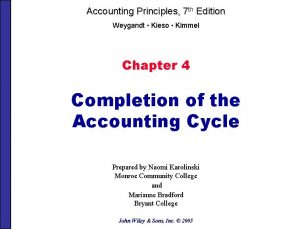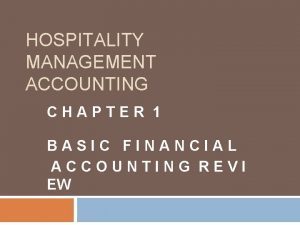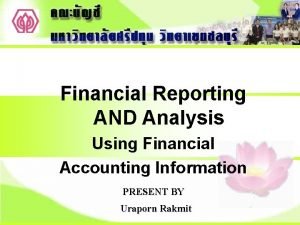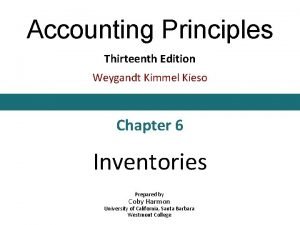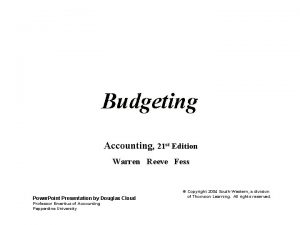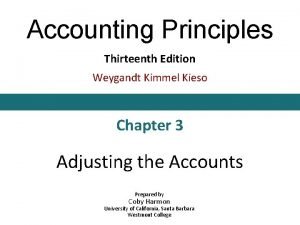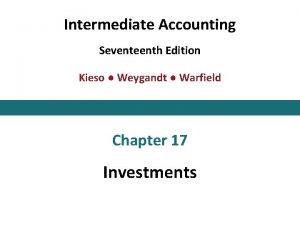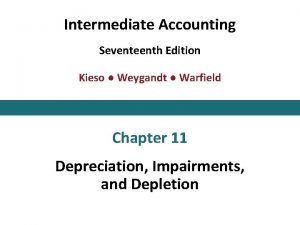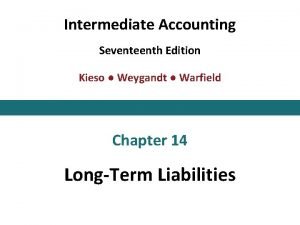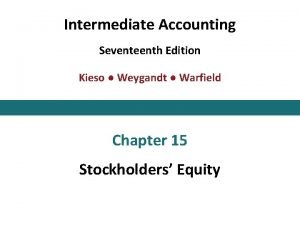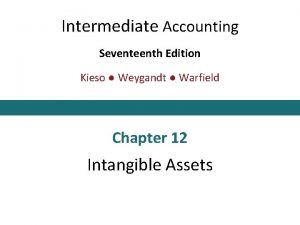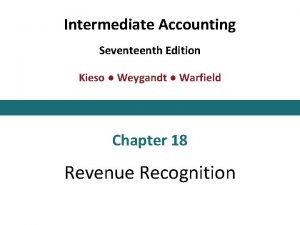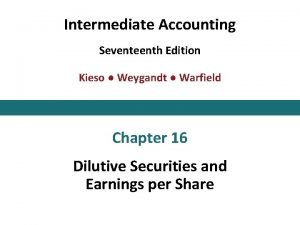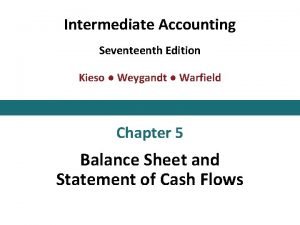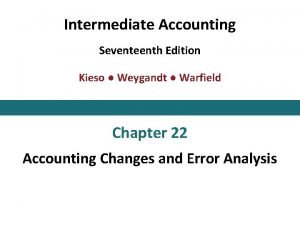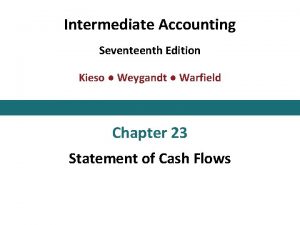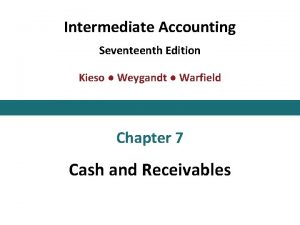Intermediate Accounting Seventeenth Edition Kieso Weygandt Warfield Chapter






















































































- Slides: 86

Intermediate Accounting Seventeenth Edition Kieso ● Weygandt ● Warfield Chapter 9 Inventories: Additional Valuation Issues This slide deck contains animations. Please disable animations if they cause issues with your device.

Learning Objectives After studying this chapter, you should be able to: 1. Describe and apply the lower-of-cost-or-net realizable value rule. 2. Describe and apply the lower-of-cost-or-market rule. 3. Identify other inventory valuation issues. 4. Determine ending inventory by applying the gross profit method. 5. Determine ending inventory by applying the retail inventory method. 6. Explain how to report and analyze inventory. Copyright © 2019 John Wiley & Sons, Inc. 2

Preview of Chapter 9 Inventories: Additional Valuation Issues Lower-of-Cost-or-Net Realizable Value • Definition • Illustration • Methods of applying • Recording • Use of allowance • Multiple periods Copyright © 2019 John Wiley & Sons, Inc. 3

Preview of Chapter 9 Lower-of-Cost-or-Market • How LCM works • Methods • Evaluation of LCNRV and LCM rules Other Valuation Approaches • Net realizable value • Relative sales value • Purchase commitments Copyright © 2019 John Wiley & Sons, Inc. 4

Preview of Chapter 9 Gross Profit Method • Gross profit percentage • Evaluation of method Retail Inventory Method • Concepts • Conventional method • Special items • Evaluation of method Copyright © 2019 John Wiley & Sons, Inc. 5

Preview of Chapter 9 Presentation and Analysis • Presentation • Analysis Copyright © 2019 John Wiley & Sons, Inc. 6

Learning Objective 1 Describe and Apply the Lower-of-Costor-Net Realizable Value Rule LO 1 Copyright © 2019 John Wiley & Sons, Inc. 7

Lower-of-Cost-or-Net Realizable Value A company abandons the historical cost principle when the future utility (revenue-producing ability) of the asset drops below its original cost. Definition of Net Realizable Value • Estimated selling price in the ordinary course of business, less reasonably predictable costs of completion, disposal, and transportation LO 1 Copyright © 2019 John Wiley & Sons, Inc. 8

Definition of Net Realizable Value Illustration Assume that Mander Corp. has unfinished inventory with a cost of $950, a sales value of $1, 000, estimated cost of completion of $50, and estimated selling costs of $200. Mander’s net realizable value is computed as follows. LO 1 Copyright © 2019 John Wiley & Sons, Inc. 9

Definition of Net Realizable Value LCNRV Disclosures • Mander reports inventory at $750 • In its income statement, Mander reports a Loss Due to Decline of Inventory to N R V of $200 ($950 − $750) Kesa Electricals Inventories are stated at the lower-of-cost-or-net realizable value. Cost is determined using the weighted average method. Net realisable value represents the estimated selling price in the ordinary course of business, less applicable variable selling expenses. LO 1 Copyright © 2019 John Wiley & Sons, Inc. 10

Illustration of LCNRV Determining Final Inventory Value – Regner Foods LO 1 Copyright © 2019 John Wiley & Sons, Inc. 11

Method of Applying LCNRV Alternative Applications of LCNRV Companies usually price inventory on an item-by-item basis. LO 1 Copyright © 2019 John Wiley & Sons, Inc. 12

Recording NRV Instead of Cost The following inventory data is for Ricardo Company. Ending inventory (cost) Ending inventory (at NRV) Adjustment $ 82, 000 70, 000 $ 12, 000 Loss Method Loss Due to Decline in Inventory 12, 000 COGS Method Cost of Goods Sold Inventory 12, 000 LO 1 Copyright © 2019 John Wiley & Sons, Inc. 12, 000 13

Recording NRV Instead of Cost Use of an Allowance Instead of crediting the Inventory account for market adjustments, companies generally use an allowance account, often referred to as Allowance to Reduce Inventory to NRV. Loss Due to Decline of Inventory to NRV Allowance to Reduce Inventory to NRV 12, 000 Presentation of Inventory Using an Allowance Account Inventory (at cost) Allowance to reduce inventory to NRV Inventory (at NRV) LO 1 Copyright © 2019 John Wiley & Sons, Inc. $ 82, 000 (12, 000) $ 70, 000 14

Recording NRV Instead of Cost Balance Sheet Loss Method Current assets: Cash Accounts receivable Inventory Less: allowance to market Prepaids Total current assets LO 1 COGS Method $ 100, 000 350, 000 770, 000 758, 000 (12, 000) 0 20, 000 $1, 228, 000 Copyright © 2019 John Wiley & Sons, Inc. 15

Recording NRV Instead of Cost Income Statement LO 1 Copyright © 2019 John Wiley & Sons, Inc. 16

Use of an Allowance—Multiple Periods In general, accountants adjust the allowance account balance at the next year-end to agree with the discrepancy between cost and the LCNRV at that balance sheet date. Date Inventory at Cost Inventory at NRV Amount Required in Valuation Account Adjustment of Valuation Account Effect on Net Balance Income Dec. 31, 2016 $188, 000 $176, 000 $12, 000 inc. Dec. 31, 2017 194, 000 187, 000 5, 000 dec. Increase Dec. 31, 2018 173, 000 174, 000 0 7, 000 dec. Increase Dec. 31, 2019 182, 000 180, 000 2, 000 inc. Decrease LO 1 Copyright © 2019 John Wiley & Sons, Inc. Decrease 17

Learning Objective 2 Describe and Apply the Lower-of Costor-Market Rule LO 2 Copyright © 2019 John Wiley & Sons, Inc. 18

Lower-of-Cost-or-Market (1 of 6) The use of the lower-of-cost-or-net realizable value method works well to measure the decline in value of a company’s inventory for most companies. FASB granted an exception to the LCNRV approach for companies that use the LIFO or retail inventory methods. • Rather than comparing cost to net realizable value companies compare a “designated market value” of inventory to cost • Approach is commonly referred to as lower-of-cost-ormarket (LCM) LO 2 Copyright © 2019 John Wiley & Sons, Inc. 19

Lower-of-Cost-or-Market Two Limitations This approach begins with replacement cost, then applies two additional limitations to value ending inventory. • Net realizable value (ceiling) • Net realizable value less a normal profit margin (floor) LO 2 Copyright © 2019 John Wiley & Sons, Inc. 20

Lower-of-Cost-or-Market Net Realizable Value (NRV) NRV is the estimated selling price in the ordinary course of business, less reasonably predictable costs of completion and disposal. A company values inventory at the lower-of-cost-or-market, with market limited to an amount that is not more than net realizable value or less than net realizable value less a normal profit margin. LO 2 Copyright © 2019 John Wiley & Sons, Inc. 21

Lower-of-Cost-or-Market Illustration Assume that Parker Corp. has unfinished inventory with a sales value of $1, 000, estimated cost of completion and disposal of $300, and a normal profit margin of 10 percent of sales. Parker determines the following net realizable value. Inventory—sales value Less: Estimated cost of completion and disposal Net realizable value Less: Allowance for normal profit margin (10% of sales) $ 1, 000 300 700 100 Net realizable value less a normal profit margin $ 600 LO 2 Copyright © 2019 John Wiley & Sons, Inc. 22

Lower-of-Cost-or-Market Inventory Valuation What is the rationale for the Ceiling and Floor limitations? LO 2 Copyright © 2019 John Wiley & Sons, Inc. 23

Lower-of-Cost-or-Market Rationale What is the rationale for the Ceiling and Floor limitations? • Ceiling – prevents overstatement of the value of obsolete, damaged, or shopworn inventories • Floor – deters understatement of inventory and overstatement of loss in current period LO 2 Copyright © 2019 John Wiley & Sons, Inc. 24

How Lower-of-Cost-or-Market Works $65, 000 Loss Due to Decline of Inventory to Market 65, 000 Allowance to Reduce Inventory to Market LO 2 Copyright © 2019 John Wiley & Sons, Inc. 25

Methods of Applying Lower-of-Cost-or. Market LO 2 Copyright © 2019 John Wiley & Sons, Inc. 26

Evaluation of L CNRV and Lower-of-Cost -or-Market Rule Conceptual deficiencies: 1. Expense recorded when loss in utility occurs. Recognize increases in the value of the asset only at point of sale. 2. Inventory valued at cost in one year and at market in next year. 3. Net income in year of loss is lower. Net income in subsequent period may be higher than normal if expected reductions in sales price do not materialize. 4. Application of these rules uses a “normal profit” in determining inventory values, which is a subjective measure. LO 2 Copyright © 2019 John Wiley & Sons, Inc. 27

Learning Objective 3 Identify Other Inventory Valuation Issues LO 3 Copyright © 2019 John Wiley & Sons, Inc. 28

Other Valuation Approaches Valuation at Net Realizable Value Permitted by G A A P under the following conditions: 1) A controlled market with a quoted price applicable to all quantities, and 2) no significant costs of disposal or 3) too difficult to obtain cost figures. LO 3 Copyright © 2019 John Wiley & Sons, Inc. 29

Other Valuation Approaches Valuation Using Relative Sale Value Used when buying varying units in a single lump-sum purchase. Illustration: Woodland Developers purchases land for $1 million that it will subdivide into 400 lots. These lots are of different sizes and shapes but can be roughly sorted into three groups graded A, B, and C. As Woodland sells the lots, it apportions the purchase cost of $1 million among the lots sold and the lots remaining on hand. Calculate the cost of lots sold and gross profit. LO 3 Copyright © 2019 John Wiley & Sons, Inc. 30

Other Valuation Approaches Allocation of Cost and Determination of Gross Profit LO 3 Copyright © 2019 John Wiley & Sons, Inc. 31

Other Valuation Approaches Purchase Commitments—A Special Problem • Generally seller retains title to merchandise • Buyer recognizes no asset or liability • If material, buyer should disclose contract details in note in the financial statements • If contract price is greater than market price, and buyer expects losses will occur when purchase is effected, buyer should recognize losses in period when such declines in market prices take place LO 3 Copyright © 2019 John Wiley & Sons, Inc. 32

Other Valuation Approaches Illustration: St. Regis Paper Co. signed timber-cutting contracts to be executed in 2021 at a price of $10, 000. Assume further that the market price of the timber cutting rights on December 31, 2020, dropped to $7, 000. St. Regis would make the following entry on December 31, 2020. Unrealized Holding Gain or Loss—Income Estimated Liability on Purchase Commitments 3, 000, 000 Other expenses and losses in the Income statement. Current liabilities on the balance sheet. LO 3 Copyright © 2019 John Wiley & Sons, Inc. 33

Other Valuation Approaches Illustration When St. Regis cuts the timber at a cost of $10 million, it would make the following entry. Purchases (Inventory) Est. Liability on Purchase Commitments Cash 7, 000 3, 000 10, 000 Assume the Congress permitted St. Regis to reduce its contract price and therefore its commitment by $1, 000. Est. Liability on Purchase Commitments 1, 000 Unrealized Holding Gain or Loss—Income LO 3 Copyright © 2019 John Wiley & Sons, Inc. 1, 000 34

Learning Objective 4 Determine Ending Inventory by Applying the Gross Profit Method LO 4 Copyright © 2019 John Wiley & Sons, Inc. 35

Gross Profit Method of Estimating Inventory Substitute Measure to Approximate Inventory 1. Beginning inventory plus purchases equal total goods to be accounted for. 2. Goods not sold must be on hand. 3. The sales, reduced to cost, deducted from the sum of the opening inventory plus purchases, equal ending inventory. LO 4 Copyright © 2019 John Wiley & Sons, Inc. 36

Gross Profit Method Illustration: Cetus Corp. has a beginning inventory of $60, 000 and purchases of $200, 000, both at cost. Sales at selling price amount to $280, 000. The gross profit on selling price is 30 percent. Cetus applies the gross margin method as follows. Beginning inventory (at cost) Purchases (at cost) Goods available (at cost) Sales (at selling price) Less: Gross profit (30% of $280, 000) Sales (at cost) Approximate inventory (at cost) LO 4 Copyright © 2019 John Wiley & Sons, Inc. $ 60, 000 200, 000 260, 000 280, 000 84, 000 196, 000 $ 64, 000 37

Gross Profit Method Computation of Gross Profit Percentage Illustration: In the previous illustration, the gross profit was a given. But how did Cetus derive that figure? To see how to compute a gross profit percentage, assume that an article cost $15 and sells for $20, a gross profit of $5. LO 4 Copyright © 2019 John Wiley & Sons, Inc. 38

Gross Profit Method Formulas LO 4 Copyright © 2019 John Wiley & Sons, Inc. 39

Gross Profit Method Application of Gross Profit Formulas LO 4 Copyright © 2019 John Wiley & Sons, Inc. 40

Gross Profit Method Illustration Astaire Company uses the gross profit method to estimate inventory for monthly reporting purposes. Presented below is information for the month of May. Inventory, May 1 $ 160, 000 Purchases (gross) 640, 000 Freight-in 30, 000 Sales 1, 000 Sales returns 70, 000 Purchase discounts 12, 000 Compute the estimated inventory at May 31, assuming that the gross profit is 25% of sales. Compute the estimated inventory at May 31, assuming that the gross profit is 25% of cost. LO 4 Copyright © 2019 John Wiley & Sons, Inc. 41

Gross Profit Method Compute the estimated inventory at May 31, assuming that the gross profit is 25% of sales. LO 4 Copyright © 2019 John Wiley & Sons, Inc. 42

Gross Profit Method Compute the estimated inventory at May 31, assuming that the gross profit is 25% of cost. 25% 100% + 25% LO 4 = 20% of sales Copyright © 2019 John Wiley & Sons, Inc. 43

Gross Profit Method Evaluation of Gross Profit Method Disadvantages: 1. It is an estimate. 2. It generally relies on past percentages in determining the markup. 3. Care must be exercised when applying a blanket gross profit rate when there are varying gross profits. Normally unacceptable for financial reporting purposes. LO 4 Copyright © 2019 John Wiley & Sons, Inc. 44

Learning Objective 5 Determine Ending Inventory by Applying the Retail Inventory Method LO 5 Copyright © 2019 John Wiley & Sons, Inc. 45

Retail Inventory Method A method used by retailers, to value inventory without a physical count, by converting retail prices to cost. Requires retailers to keep: 1. Total cost and retail value of goods purchased. 2. Total cost and retail value of goods available for sale. 3. Sales for the period. LO 5 Copyright © 2019 John Wiley & Sons, Inc. 46

Retail Inventory Method Illustration Fuque Inc. uses the retail inventory method to estimate ending inventory for its monthly financial statements. The following data pertain to a single department for the month of October. Instructions: Prepare a schedule computing retail inventory using the following methods: 1. Conventional (LCM) 2. Cost LO 5 Copyright © 2019 John Wiley & Sons, Inc. 47

Retail Inventory Method Data for October Cost Beg. inventory, Oct. 1 $ 52, 000 $ 78, 000 Purchases 272, 000 Freight in 16, 600 Purchase returns 5, 600 423, 000 8, 000 Additional markups 9, 000 Markup cancellations 2, 000 Markdowns (net) 3, 600 Normal spoilage 10, 000 Sales LO 5 Retail 390, 000 Copyright © 2019 John Wiley & Sons, Inc. 48

Conventional Method LO 5 Copyright © 2019 John Wiley & Sons, Inc. 49

Cost Method LO 5 Copyright © 2019 John Wiley & Sons, Inc. 50

Special Items Relating to Retail Method • Freight costs • Purchase returns • Purchase discounts and allowances • Transfers-in • Normal shortages • Abnormal shortages • Employee discounts LO 5 Copyright © 2019 John Wiley & Sons, Inc. 51

Retail Inventory Method Conventional Method – Special Items Included LO 5 Copyright © 2019 John Wiley & Sons, Inc. 52

Evaluation of Retail Inventory Method Used for the following reasons: 1. To permit the computation of net income without a physical count of inventory. 2. Control measure in determining inventory shortages. 3. Regulating quantities of merchandise on hand. 4. Insurance information. Some companies refine the retail method by computing inventory separately by departments or class of merchandise with similar gross profits. LO 5 Copyright © 2019 John Wiley & Sons, Inc. 53

Learning Objective 6 Explain How to Report and Analyze Inventory LO 6 Copyright © 2019 John Wiley & Sons, Inc. 54

Presentation and Analysis Presentation of Inventories Accounting standards require disclosure of: 1. Composition of the inventory, inventory financing arrangements, and the inventory costing methods employed. 2. Consistent application of costing methods from one period to another. 3. Inventory composition either in the balance sheet or in a separate schedule in the notes. LO 6 Copyright © 2019 John Wiley & Sons, Inc. 55

Presentation and Analysis Presentation of Inventories Accounting standards require disclosure of: 4. Significant or unusual financing arrangements relating to inventories. 5. Inventories pledged as collateral for a loan in the current asset section rather than as an offset to the liability. 6. Basis on which it states inventory amounts (lower ofcost-or-market) and the method used in determining cost (LIFO, FIFO, average cost, etc. ). LO 6 Copyright © 2019 John Wiley & Sons, Inc. 56

Disclosure of Inventory Methods LO 6 Copyright © 2019 John Wiley & Sons, Inc. 57

Disclosure of Trade Practice in Valuing Inventories LO 6 Copyright © 2019 John Wiley & Sons, Inc. 58

Analysis of Inventories Common ratios used in the management and evaluation of inventory levels are inventory turnover and average days to sell the inventory. LO 6 Copyright © 2019 John Wiley & Sons, Inc. 59

Analysis of Inventories Inventory Turnover Measures the number of times on average a company sells the inventory during the period. Illustration: In its 2017 annual report Kellogg Company reported a beginning inventory of $1, 238 million, an ending inventory of $1, 217 million, and cost of goods sold of $7, 901 million for the year. LO 6 Copyright © 2019 John Wiley & Sons, Inc. 60

Analysis of Inventories Average Days to Sell Inventory Measure represents the average number of days’ sales for which a company has inventory on hand. Average Days to Sell 365 days / 6. 44 times = every 56. 7 days LO 6 Copyright © 2019 John Wiley & Sons, Inc. 61

Learning Objective 7 Determine Ending Inventory by Applying the LIFO Retail Methods LO 7 Copyright © 2019 John Wiley & Sons, Inc. 62

Appendix 9 A: LIFO Retail Methods Primary reason to use L I F O • Tax advantages • Results in a better matching of costs and revenues • Use of LIFO retail is made under two assumptions: 1. stable prices and 2. fluctuating prices. LO 7 Copyright © 2019 John Wiley & Sons, Inc. 63

Stable Prices—LIFO Retail Methods A major assumption of the LIFO retail method is that the markups and markdowns apply only to the goods purchased during the current period and not to the beginning inventory. LO 7 Copyright © 2019 John Wiley & Sons, Inc. 64

LIFO Retail Inventory Method Data for October Cost Beg. inventory, Oct. 1 $ 52, 000 $ 78, 000 Purchases 272, 000 Freight in 16, 600 Purchase returns 5, 600 423, 000 8, 000 Additional markups 9, 000 Markup cancellations 2, 000 Markdowns (net) 3, 600 Normal spoilage 10, 000 Sales LO 5 LO 7 Retail 390, 000 Copyright © 2019 John Wiley & Sons, Inc. 65

LIFO Retail Methods LO 7 Copyright © 2019 John Wiley & Sons, Inc. 66

Stable Prices—LIFO Retail Methods Hernandez Company LO 7 Copyright © 2019 John Wiley & Sons, Inc. 67

Stable Prices—LIFO Retail Methods Ending Inventory at LIFO Cost 2020 Inventory is composed of two layers. LO 7 Copyright © 2019 John Wiley & Sons, Inc. 68

Stable Prices—LIFO Retail Methods Ending Inventory at LIFO Cost 2021 Notice that the 2020 layer is reduced from $11, 000 to $5, 000. LO 7 Copyright © 2019 John Wiley & Sons, Inc. 69

Fluctuating Prices—Dollar-Value LIFO Retail If the price level does change, the company must eliminate the price change so as to measure the real increase in inventory, not the dollar increase. LO 7 Copyright © 2019 John Wiley & Sons, Inc. 70

Fluctuating Prices—Dollar-Value LIFO Retail Illustration Assume that the beginning inventory had a retail market value of $10, 000 and the ending inventory had a retail market value of $15, 000. Assume further that the price level has risen from 100 to 125. It is inappropriate to suggest that a real increase in inventory of $5, 000 has occurred. Instead, the company must deflate the ending inventory at retail. LO 7 Copyright © 2019 John Wiley & Sons, Inc. 71

Fluctuating Prices Ending Inventory at Retail—Deflated and Restated LO 7 Copyright © 2019 John Wiley & Sons, Inc. 72

Fluctuating Prices Dollar-Value LIFO Retail Method—Fluctuating Prices LO 7 Copyright © 2019 John Wiley & Sons, Inc. 73

Fluctuating Prices Dollar-Value LIFO Retail Method—Fluctuating Prices Illustration: From this information, we compute the inventory amount at cost: Hernandez must restate layers of a particular year to the prices in effect in the year when the layer was added. LO 7 Copyright © 2019 John Wiley & Sons, Inc. 74

Fluctuating Prices Comparison of Effects of Price Assumptions Difference between the L I F O approach (stable prices) and the dollar-value L I F O method. LIFO (stable prices) LIFO (fluctuating prices) Beginning inventory $27, 000 Increment 7, 700 3, 920 Ending inventory $34, 700 $30, 920 The difference of $3, 780 results from an increase in the price of goods, not from an increase in the quantity of goods. LO 7 Copyright © 2019 John Wiley & Sons, Inc. 75

Subsequent Adjustments Under Dollar. Value L IFO Retail Illustration: Using the data from the previous example, assume that the retail value of the 2021 ending inventory at current prices is $64, 800, the 2021 price index is 120 percent of base-year, and the cost-to-retail percentage is 75 percent. LO 7 Copyright © 2019 John Wiley & Sons, Inc. 76

Subsequent Adjustments Decreased Ending Inventory at LIFO Cost Illustration: Conversely assume that in 2021 the ending inventory in base-year prices is $48, 000. Compute the ending inventory at LIFO cost. LO 7 Copyright © 2019 John Wiley & Sons, Inc. 77

Changing From Conventional Retail to LIFO Illustration: Hackman Clothing Store employs the conventional retail method but wishes to change to the LIFO retail method beginning in 2021. The amounts shown by the firm’s books are as follows. Hakeman Clothing Store Inventory, January 1, 2020 Net purchases in 2020 Net markups in 2020 At Cost $ 5, 210 47, 250 Net markdowns in 2020 Sales revenue in 2020 LO 7 Copyright © 2019 John Wiley & Sons, Inc. At Retail $ 15, 000 100, 000 7, 000 2, 000 95, 000 78

Conventional Retail Inventory Method LO 7 Copyright © 2019 John Wiley & Sons, Inc. 79

Conversion to LIFO Retail Inventory Method Ha. Ckman Clothing can then quickly approximate the ending inventory for 2020 under the LIFO retail method. LO 7 Copyright © 2019 John Wiley & Sons, Inc. 80

Learning Objective 8 Compare the Accounting Procedures Related to Valuation of Inventories Under GAAP and IFRS LO 8 Copyright © 2019 John Wiley & Sons, Inc. 81

IFRS Insights Relevant Facts - Similarities • I F R S and G A A P account for inventory acquisitions at historical cost and evaluate inventory for L C N R V subsequent to acquisition. • Who owns the goods—goods in transit, consigned goods, special sales agreements—as well as the costs to include in inventory are essentially accounted for the same under I F R S and G A A P. LO 8 Copyright © 2019 John Wiley & Sons, Inc. 82

IFRS Insights Relevant Facts - Differences • The requirements for accounting for and reporting inventories are more principles-based under IFRS. That is, GAAP provides more detailed guidelines in inventory accounting. • A major difference between IFRS and GAAP relates to the LIFO cost flow assumption. GAAP permits the use of LIFO for inventory valuation. IFRS prohibits use. FIFO and average-cost are the only two acceptable cost flow assumptions permitted under IFRS. Both sets of standards permit specific identification where appropriate. • IFRS does not have an exception to the LCNRV rule for the L IFO /retail inventory methods (IFRS does not allow LIFO). GAAP, on the other hand, for LIFO /retail inventory method companies, defines market as replacement cost subject to the constraints of net realizable value (the ceiling) and net realizable value less a normal markup (the floor). I FRS does not use a ceiling or a floor to determine lower-of-cost-or-market. LO 8 Copyright © 2019 John Wiley & Sons, Inc. 83

IFRS Insights Relevant Facts - Differences • Under GAAP, if inventory is written down under the L CNRV or lower-ofcost-or-market valuation, the new basis is now considered its cost. As a result, the inventory may not be written back up to its original cost in a subsequent period. Under IFRS, the write-down may be reversed in a subsequent period up to the amount of the previous write-down. Both the write-down and any subsequent reversal should be reported on the income statement. • IFRS requires both biological assets and agricultural produce at the point of harvest to be reported at net realizable value. G AAP does not require companies to account for all biological assets in the same way. Furthermore, these assets generally are not reported at net realizable value. Disclosure requirements also differ between the two sets of standards. LO 8 Copyright © 2019 John Wiley & Sons, Inc. 84

IFRS Insights On The Horizon One issue that will be difficult to resolve relates to the use of the LIFO cost flow assumption. As indicated, IFRS specifically prohibits use. Conversely, the LIFO cost flow assumption is widely used in the United States because of its favorable tax advantages. In addition, many argue that LIFO from a financial reporting point of view provides a better matching of current costs against revenue and therefore enables companies to compute a more realistic income. LO 8 Copyright © 2019 John Wiley & Sons, Inc. 85

Copyright © 2019 John Wiley & Sons, Inc. All rights reserved. Reproduction or translation of this work beyond that permitted in Section 117 of the 1976 United States Act without the express written permission of the copyright owner is unlawful. Request for further information should be addressed to the Permissions Department, John Wiley & Sons, Inc. The purchaser may make back-up copies for his/her own use only and not for distribution or resale. The Publisher assumes no responsibility for errors, omissions, or damages, caused by the use of these programs or from the use of the information contained herein. Copyright © 2019 John Wiley & Sons, Inc. 86
 Kieso weygandt warfield
Kieso weygandt warfield Economic entity assumption
Economic entity assumption Kimmel weygandt kieso accounting 5th edition
Kimmel weygandt kieso accounting 5th edition Kimmel weygandt kieso accounting 5th edition
Kimmel weygandt kieso accounting 5th edition Financial and managerial accounting weygandt kimmel kieso
Financial and managerial accounting weygandt kimmel kieso Weygandt kimmel kieso
Weygandt kimmel kieso Chapter 21 accounting for leases kieso terjemahan
Chapter 21 accounting for leases kieso terjemahan Chapter 14 intermediate accounting kieso bahasa indonesia
Chapter 14 intermediate accounting kieso bahasa indonesia Chapter 17 intermediate accounting
Chapter 17 intermediate accounting Intermediate accounting kieso
Intermediate accounting kieso Intermediate accounting kieso
Intermediate accounting kieso Intermediate accounting kieso
Intermediate accounting kieso Intermediate accounting kieso
Intermediate accounting kieso Intermediate accounting kieso
Intermediate accounting kieso Intermediate accounting kieso
Intermediate accounting kieso Intermediate accounting kieso
Intermediate accounting kieso System of accounting
System of accounting Idalinsip
Idalinsip Chapter 4 american life in the seventeenth century
Chapter 4 american life in the seventeenth century American life in the seventeenth century
American life in the seventeenth century Chapter 4 american life in the seventeenth century
Chapter 4 american life in the seventeenth century Chapter 4 american life in the seventeenth century
Chapter 4 american life in the seventeenth century Scott warfield ucf
Scott warfield ucf Scott warfield ucf
Scott warfield ucf Sarah warfield
Sarah warfield Intermediate accounting revenue recognition
Intermediate accounting revenue recognition Kieso chapter 18 revenue recognition terjemahan
Kieso chapter 18 revenue recognition terjemahan Chapter 16 kieso
Chapter 16 kieso Summer of the seventeenth doll quotes
Summer of the seventeenth doll quotes Cost of retained earnings
Cost of retained earnings Patent impairment
Patent impairment Accounting for current liabilities and contingencies
Accounting for current liabilities and contingencies Chapter 19 accounting for income taxes
Chapter 19 accounting for income taxes Chapter 7 kas dan piutang
Chapter 7 kas dan piutang A restriction/appropriation of retained earnings
A restriction/appropriation of retained earnings Chapter 10 property plant and equipment
Chapter 10 property plant and equipment Chapter 2 conceptual framework for financial reporting
Chapter 2 conceptual framework for financial reporting Chapter 11 depreciation impairments and depletion
Chapter 11 depreciation impairments and depletion Chapter 3 intermediate accounting
Chapter 3 intermediate accounting Chapter 15 intermediate accounting
Chapter 15 intermediate accounting Intermediate accounting chapter 1
Intermediate accounting chapter 1 Liablities
Liablities Conceptual framework levels
Conceptual framework levels Chapter 7 cash and receivables
Chapter 7 cash and receivables Net realizable value formula
Net realizable value formula Intermediate accounting chapter 23
Intermediate accounting chapter 23 Intermediate accounting chapter 5
Intermediate accounting chapter 5 Intermediate accounting chapter 1
Intermediate accounting chapter 1 Ekuitas saham adalah
Ekuitas saham adalah Chapter 21 intermediate accounting
Chapter 21 intermediate accounting Intermediate accounting chapter 4
Intermediate accounting chapter 4 Intermediate accounting chapter 1
Intermediate accounting chapter 1 Intermediate accounting chapter 17 investments test bank
Intermediate accounting chapter 17 investments test bank Chapter 15 intermediate accounting
Chapter 15 intermediate accounting Large stock dividend journal entry
Large stock dividend journal entry Intermediate accounting chapter 11
Intermediate accounting chapter 11 Chapter 12 intangible assets
Chapter 12 intangible assets Financial accounting ifrs 4th edition chapter 12
Financial accounting ifrs 4th edition chapter 12 Accounting 1 7th edition chapter 7
Accounting 1 7th edition chapter 7 Lessor versus lessee
Lessor versus lessee Secured borrowing journal entries
Secured borrowing journal entries Intermediate accounting
Intermediate accounting Gaap principles
Gaap principles Intermediate accounting
Intermediate accounting Cash and receivables intermediate accounting
Cash and receivables intermediate accounting Intermediate accounting
Intermediate accounting Intermediate accounting
Intermediate accounting Intermediate financial accounting
Intermediate financial accounting Intermediate financial accounting
Intermediate financial accounting In a service-type warranty, warranty revenue is
In a service-type warranty, warranty revenue is Income statement discontinued operations
Income statement discontinued operations The lifo conformity rule
The lifo conformity rule Revenue recognition intermediate accounting
Revenue recognition intermediate accounting Khan academy intermediate value theorem
Khan academy intermediate value theorem Using mis 10th edition
Using mis 10th edition Using mis (10th edition)
Using mis (10th edition) Accounting principles second canadian edition
Accounting principles second canadian edition Accounting principles second canadian edition
Accounting principles second canadian edition Accounting principles second canadian edition
Accounting principles second canadian edition Kimmel financial accounting 7the edition
Kimmel financial accounting 7the edition Hotel management accounts format
Hotel management accounts format Using financial accounting information 10th edition
Using financial accounting information 10th edition Accounting principles 13th edition
Accounting principles 13th edition Accounting principles second canadian edition
Accounting principles second canadian edition Warren reeve fess accounting edition 21
Warren reeve fess accounting edition 21 Accounting principles 13th edition
Accounting principles 13th edition What is computerized accounting?
What is computerized accounting?
